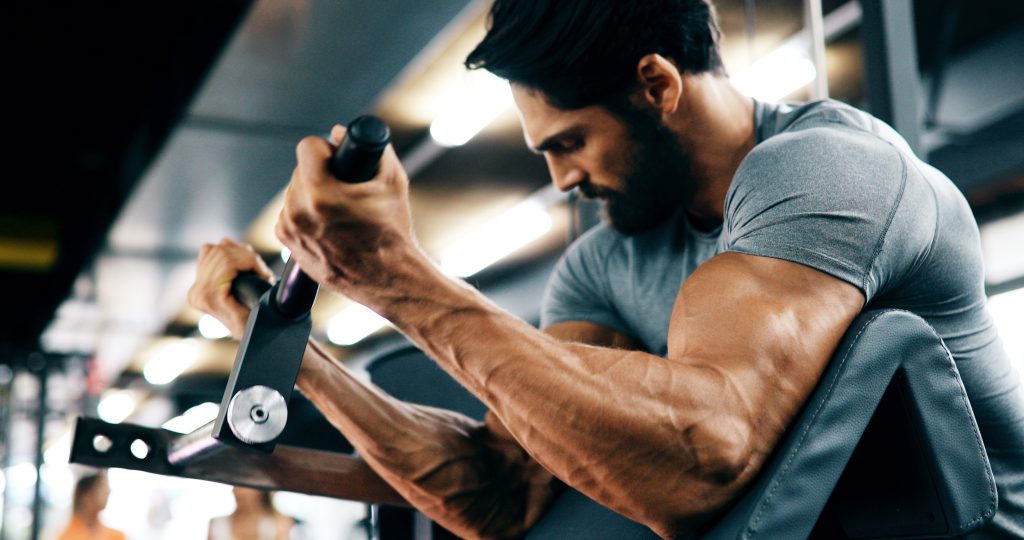
With a well-designed training plan you will be able to see the outlined muscles after about 4 weeks from the start of training
A proper diet is also very important, thanks to which the effect will last longer. Be sure to check out how to get a beautifully sculpted physique in no time!
Workout for sculpting should include not only exercises with weights, but also interval and aerobic training. This will allow us to maintain a slim figure, but also burn excess body fat. Aerobic training is also necessary to train muscle endurance and increase fitness.
If we care about nicely outlined muscles, surely a very important element will be keeping proper breaks between series. This type of training is very intensive, that is why we should not take breaks between series or they can last up to 30 seconds. The point is to maintain the intensity of the workout and make the muscles develop at an even pace.
Training for individual parts consists of 3 or 4 series. For example, 3 series of 15 repetitions are recommended for small muscle parts, and 4 series of 10 repetitions are recommended for larger ones. In case of increasing the number of series, the number of repetitions can be slightly decreased.
Very important information is the fact that sculpting training should be done by people who previously were on reduction or so called mass. Otherwise this style of training will not make sense. Exercises designed to sculpt muscles are extremely intensive. For them to be effective we must first minimize the amount of fat tissue. Only in this way will the sculpted muscles be visible at all.
Such workouts are not recommended for beginners, because their muscles are not adapted to such intense exercises.

Many people care about sculpting the abdominal muscles, because they are the most impressive. Getting nicely outlined muscles on the abdomen will require us to work out and change our eating habits. It is essential to get rid of excess body fat through aerobic and interval training. Remember that we do not lose weight from one part of the body, but from the whole
To make the abdominal muscles nicely outlined, you will need a separate workout for oblique and lateral muscles and straight muscles. Doing abdominals is not everything: it is recommended to raise your legs while hanging on a bar, raise your legs on a bench and the so-called russian twist. It involves twisting the trunk while sitting on a mat. Its slightly more difficult version also includes legs raised above the mat, slightly bent at the knees.
While sculpting your abdomen you can’t forget about your diet! Forget about sweets and hard to digest foods. While sculpting your best friend will be light salads, lean poultry and dairy products, mineralized water and fruit. Eating easy to digest and ensuring adequate amounts of protein in your diet, you will surely notice great results quickly.
Since this type of workout is very intense, it should last a maximum of 40 minutes. It includes exercises with weights, push-ups, as well as leg raises on a bar or training on machines with extra weight, such as an atlas
If you do the sculpting workout at home, you will rely mainly on your own body weight. You should then increase the intensity of the exercises by increasing the number of sets.
In addition to the sculpting training, do not forget about the necessary warm-up and aerobic exercises. It’s a good idea to set aside days when you will focus more on strength training, and during the remaining days you will remain with aerobic and high intensity interval training.
Day 1 – aerobic training: 10 minute warm-up (dynamic stretching, bends, a few jumps, fast walking on the spot or orbitrek – 5-8 minutes), 40 minutes of bicycle or treadmill at different levels of incline, stretching, calming breathing.
Day 2 – training for sculpture: same as before 10 minute warm-up, leg raises while hanging on a bar 3 x 15-20, jackknives (V-up) 3 x 15-20, trunk raises towards feet with straight legs raised 3 x 15-20, russian Twist 3 x 60 seconds, plank for 20 seconds, abdominals on a ball 3×20, leg raises lying on a bench (oblique down) 3 x 15, 15-20 minutes of exercise on an orbitrek or rowing machine, stretching, calming breathing.
Day 3 – active recreation – Nordic walking, recreational swimming.
Day 4 – warm-up and interval training of varying intensity – jumping jacks, burpees, jumping jacks, jumping jacks with knee raises to chest, jogging in place – maximum 40 second breaks between sets, 15-20 minutes on a stationary bike, stretching and calming breathing.
Day 5 – sculpting workout from the schedule of day 2.
Day 6 – active rest – slow jogging, Nordic walking, swimming, yoga.
Day 7 – regeneration.
Main photo: Vasyl/Adobe Stock